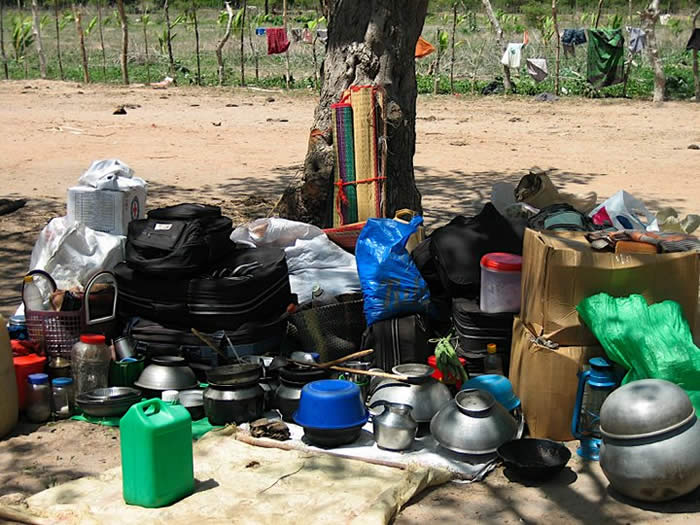HRW: End Internment of Displaced Persons
Government Illegally Holding Civilians Fleeing Fighting in the North
by Human Rights Watch, July 2, 2008
|
Walter Kälin, the United Nations secretary-general’s representative on IDPs,... noted that “while the need to address security may be a component of the plan [to receive IDPs], it should be humanitarian and civilian in nature. In particular, IDPs’ freedom of movement must be respected, and IDPs may not be confined to a camp.” ...
"The Sri Lankan government shouldn’t treat civilians as criminals just because they’re fleeing a conflict area." -
Brad Adams, Asia director at Human Rights Watch |
(New York, July 2, 2008) – The Sri Lankan government should end the arbitrary detention of more than 400 civilians displaced by recent fighting at a newly established camp in northern Sri Lanka, Human Rights Watch said today.
 Since March 2008, the government of Sri Lanka has detained civilians fleeing areas controlled by the rebel Liberation Tigers of Tamil Eelam (LTTE) at a so-called welfare center in Kalimoddai, Mannar district. The Sri Lankan armed forces have imposed severe restrictions on freedom of movement, instituting a daily pass system that limits to 30 the number of people who can leave the camp each day, and only if a family member remains behind to guarantee the detainees return in the evening. No court has authorized their detention and no charges have been filed against any of the camp’s occupants, in violation of international human rights law. Since March 2008, the government of Sri Lanka has detained civilians fleeing areas controlled by the rebel Liberation Tigers of Tamil Eelam (LTTE) at a so-called welfare center in Kalimoddai, Mannar district. The Sri Lankan armed forces have imposed severe restrictions on freedom of movement, instituting a daily pass system that limits to 30 the number of people who can leave the camp each day, and only if a family member remains behind to guarantee the detainees return in the evening. No court has authorized their detention and no charges have been filed against any of the camp’s occupants, in violation of international human rights law.
“The Sri Lankan government shouldn’t treat civilians as criminals just because they’re fleeing a conflict area,” said Brad Adams, Asia director at Human Rights Watch. “Valid security concerns should be addressed on a case-by-case basis, not with wholesale restrictions on freedom of movement.”
Sri Lankan authorities maintain that detention at the camp is a security measure to protect displaced persons from possible LTTE reprisals. While the government has an obligation to protect internally displaced persons (IDPs), it cannot do so at the expense of their lawful rights to liberty and freedom of movement, Human Rights Watch said. The security rationale is also undermined by the government’s practice in the last two months of also detaining at the Kalimoddai center at least 10 refugees who have returned from India. The Sri Lankan army has publicly indicated that Kalimoddai is just the first of more proposed sites in Vavuniya district to detain persons fleeing fighting in the LTTE-held Vanni.
On May 10 and 11, local authorities conducted a survey in Kalimoddai camp to assess the wishes of displaced persons on their preferred place of residence. Out of the then camp population of 257, only five families indicated a wish to remain in Kalimoddai. The large majority indicated that they wished to leave and had alternative places to stay, including with nearby host families. To date, unconfirmed information indicates only 28 people have been released.
International human rights law and international humanitarian law during internal armed conflicts prohibit arbitrary detention and unnecessary restrictions on freedom of movement.
In his May 21 report to the UN Human Rights Council on his December 2007 visit to Sri Lanka, Walter Kälin, the United Nations secretary-general’s representative on IDPs, emphasized that IDPs in Sri Lanka remained “entitled to all guarantees of international human rights and international humanitarian law subscribed to by the State.” He noted that “while the need to address security may be a component of the plan [to receive IDPs], it should be humanitarian and civilian in nature. In particular, IDPs’ freedom of movement must be respected, and IDPs may not be confined to a camp.”
The UN Guiding Principles on Internal Displacement, an authoritative framework for the protection of IDPs, provides that, consistent with the right to liberty, internally displaced persons “shall not be interned in or confined to a camp.” The principles recognize that “exceptional circumstances” may permit confinement only for so long as it is “absolutely necessary,” but the Sri Lankan government has not demonstrated that such circumstances exist.
Intensified military operations in 2008 against LTTE-controlled areas in the north have significantly increased displacement of the civilian population. Virtually all those displaced are of Tamil ethnicity. During the course of the two-decade-long armed conflict with the LTTE, Sri Lankan authorities have frequently restricted the movement of ethnic Tamils, especially Tamil displaced persons.
In addition to concerns about those who fled to government-controlled areas, many of the displaced who remain in LTTE areas are in need of humanitarian assistance. The Sri Lankan government has severely restricted humanitarian access to LTTE-controlled areas, leaving an estimated 107,000 displaced persons with inadequate relief, including water and sanitation facilities. Meanwhile, the LTTE continues to prevent civilians from leaving areas under its control, thereby impeding their ability to seek safety in other parts of the country.
“Both the LTTE and the government have a poor record of providing aid to populations at risk,” said Adams. “Ensuring that humanitarian organizations have access to those affected by the fighting should be a priority concern, not an afterthought.”
|
 Home
Home Archives
Archives